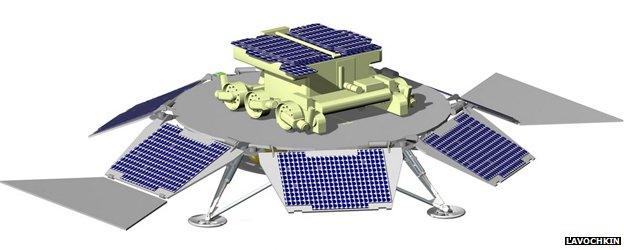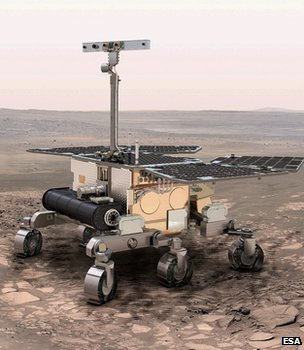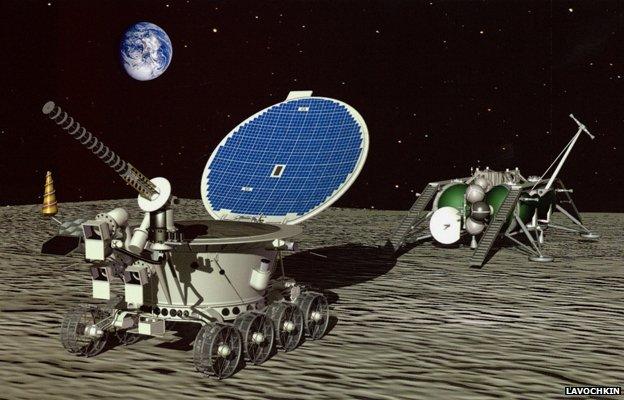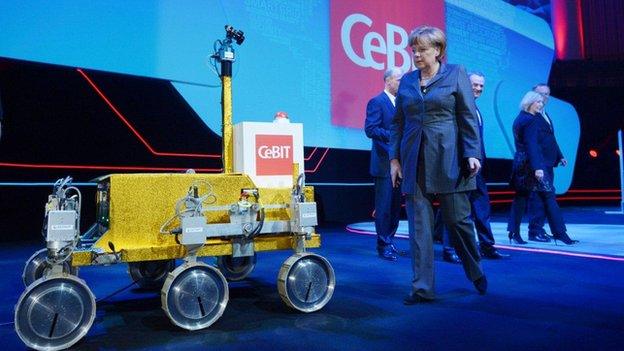Looking forward to Europe's 'seven minutes of terror'
- Published
- comments

Lavochkin is still working through the potential configurations for its ExoMars landing mechanism
An important decision will be taken shortly that will have a major bearing on Europe's ExoMars rover, due to be sent to the Red Planet in 2018.
A choice has to be made on the configuration of the rover's undercarriage - its rocker-bogie system.
Two companies - Ruag of Switzerland and MDA of Canada - were asked to produce competing six-wheeled demonstrators that were nicknamed "Bradley" and "Bruno".
You may have seen them or their predecessor prototype, "Bridget", at various shows around Europe in recent years.
The billion-euro project has however got to the point where it must move forward with a single design, and either Ruag or MDA will now be contracted to build it.
This week, the European Space Agency (Esa) released another 70 million euros to advance the rover mission towards its date with a Proton launch rocket in May 2018.
More money is required, of course, and where it will come from has yet to be precisely determined, but for the moment the venture remains officially "on track".
That is in large part thanks to the Russians who have stepped into the gaping hole left by the Americans' retreat from ExoMars in early 2012.
As well as that Proton, Russia's key contribution to 2018 will be the mechanism that gets the rover down to the surface of the Red Planet.

The design of the rover itself is well advanced
This will be built by Lavochkin, which produced the extraordinary 1970s Lunokhod Moon rovers, one of which drove more than 40km, external. And it is probably worth keeping these vehicles in mind because some of the kit that Lavochkin is proposing for ExoMars' descent is reminiscent of its old technology.
The Lunokhods came down on legged landers that then deployed ramps for the rovers to drive down. The 350kg ExoMars will do something very similar.
Of course, the big difference between Mars and the Moon is that the latter is an airless body. An atmosphere must be negotiated at Mars and that can cause all kinds of grief.
ExoMars will be encapsulated in a heatshield-protected module when it arrives at the Red Planet in early 2019, travelling at some 6km/s.
It will be the classic "seven minutes of terror" as the engineering tries to slow the velocity to no more than 1m/s by the time ExoMars reaches the surface.
Lavochkin's current strategy is to use two parachutes - one opened while the module is still moving at supersonic speeds, and another deployed once subsonic flight has been achieved.
As we saw with Nasa's Curiosity vehicle last year, the heatshield will eventually fall away from the entry capsule to allow ExoMars to emerge also, riding its retro-rocket-equipped lander.
The last kilometre or so to the ground is guided by radar, which sends information about the approaching surface to the lander's pulsed thrusters. Hopefully, we'll hear the rover operations team, who'll be based in Turin, Italy, call out "Tango Delta Nominal", or some such equivalent, to indicate a soft, safe contact.

The Lunokhod Moon rovers arrived on legged landers that deployed ramps for the vehicles to drive down
Europe's one and only attempt to land on Mars in 2003 ended in failure. The Russians have tried many times and have not had any success really worth talking about. So there is huge pressure on both parties to get the 2019 touchdown right.
It should help that some key technologies will have been tested on the "other" ExoMars mission in 2016. This is the satellite that will search for methane and other trace gases in the planet's atmosphere. The intention is for the satellite to despatch a short-lived, battery-operated weather station to the surface as soon as it arrives.

ExoMars will use a drill to get up to 2m below the surface of Mars
The sub-sonic parachute, the radar and the GNC (guidance, navigation and control) system used to get this station to the ground will all be re-used in Lavochkin's lander a year and a half later.
"We should learn a lot in 2016," says Vincenzo Giorgio who leads the ExoMars industrial project at prime contractor Thales Alenia Space. "These systems will be thoroughly tested. The radar, for example, we are about to start testing on a helicopter next week. And we will take it also to Morocco, near Marrakesh, to a terrain that looks very much like Mars."
Incidentally, the Russians plan to put a meteorological station on the rover's lander, with the difference being that it will be powered by a radioisotope thermoelectric generator - a nuclear battery. This will give the weather sensors long-term power.
We have to hope it all works. ExoMars has been such a long-drawn-out affair, I'm not sure I could bear a crash-and-burn story in 2019.
The vehicle will go with a suite of nine instruments that will for the first time since Viking try to answer the "is there life on Mars?" question. Recent missions have restricted themselves to chasing the history of water on the planet and wondering whether conditions in the past might have been habitable. ExoMars will have a stab at looking for microbe activity and will drill up to 2m into the ground to look for clues. Its big onboard lab, Moma, external, will check dirt samples for organic chemistry linked to biology.
"We have to do this and we have to succeed," Esa's director of science, Alvaro Gimenez, told me this week. "It's not going to be easy but it should be really exciting."

German chancellor Angela Merkel with the "Bridget" ExoMars prototype at this year's Cebit technology show